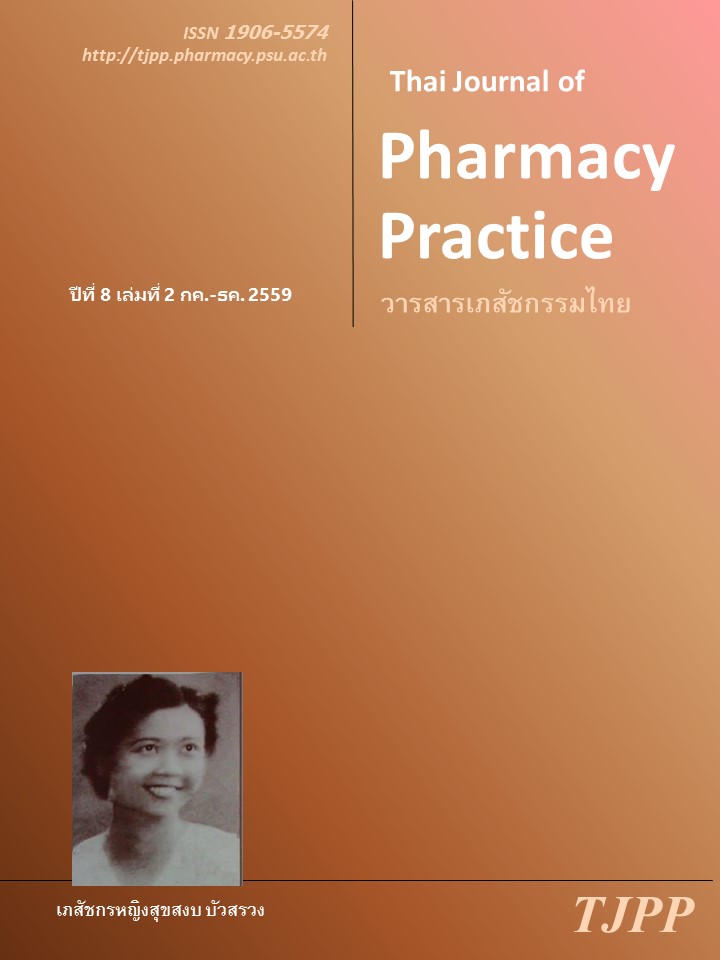ผลการบริบาลทางเภสัชกรรมในผู้ป่วยนอกโรคจิตเภท: การวิจัยเชิงทดลองแบบสุ่ม
Main Article Content
บทคัดย่อ
วัตถุประสงค์: เพื่อเปรียบเทียบผลของการบริบาลทางเภสัชกรรมกับบริการตามปกติในผู้ป่วยนอกโรคจิตเภทในเรื่องของความร่วมมือในการใช้ยา ความรู้เรื่องโรค และปัญหาที่เกิดจากการใช้ยา วิธีการ: แบบของการวิจัยเป็นการศึกษาเชิงทดลองแบบสุ่มที่เก็บข้อมูลไปข้างหน้า ตัวอย่างเป็นผู้ป่วยนอกโรคจิตเภทในคลินิกลีลาวดี โรงพยาบาลมหาสารคาม จำนวน 69 ราย ผู้วิจัยสุ่มตัวอย่างออกเป็นกลุ่มควบคุม (37 ราย) ซึ่งได้รับบริการตามปกติ และกลุ่มทดลอง (32 ราย) ซึ่งได้รับความรู้เรื่องโรคและการรักษา บริบาลทางเภสัชกรรม ร่วมกับการโทรศัพท์ติดตามสัปดาห์ละครั้ง นาน 4 สัปดาห์ (วันที่ 7, 14, 21, และ 28) ผลการวิจัย: ขณะแรกรับ เพศ อายุ การมีผู้ดูแล ความร่วมมือในการใช้ยา ความรู้เกี่ยวกับโรคและยา และปัญหาการใช้ยาในผู้ป่วยทั้ง 2 กลุ่มไม่แตกต่างกันอย่างมีนัยสำคัญ ยกเว้นกลุ่มควบคุมลืมรับประทานยามากกว่ากลุ่มทดลอง เมื่อสิ้นสุดการศึกษาพบว่า ความร่วมมือในการใช้ยาของกลุ่มทดลองและกลุ่มควบคุมไม่แตกต่างกัน (p=0.109) กลุ่มทดลองมีความรู้เรื่องโรคและยามากกกว่ากลุ่มควบคุมอย่างมีนัยสำคัญ (p<0.001) เมื่อเปรียบเทียบภายในแต่ละกลุ่มตัวอย่างพบว่า อาการไม่พึงประสงค์ลดลงอย่างมีนัยสำคัญทั้งในกลุ่มทดลองและกลุ่มควบคุม (p<0.001 และ p=0.002 ตามลำดับ) สรุป: การบริบาลทางเภสัชกรรมผู้ป่วยนอกโรคจิตเภท พร้อมกับการให้ความรู้และการแก้ไขปัญหาที่เกิดจากยา พร้อมให้คู่มือ และติดตามผู้ป่วยทางโทรศัพท์สามารถเพิ่มความรู้เกี่ยวกับโรคและยา และลดปัญหาที่เกิดจากการใช้ยาบางประการได้
Article Details
ผลการวิจัยและความคิดเห็นที่ปรากฏในบทความถือเป็นความคิดเห็นและอยู่ในความรับผิดชอบของผู้นิพนธ์ มิใช่ความเห็นหรือความรับผิดชอบของกองบรรณาธิการ หรือคณะเภสัชศาสตร์ มหาวิทยาลัยสงขลานครินทร์ ทั้งนี้ไม่รวมความผิดพลาดอันเกิดจากการพิมพ์ บทความที่ได้รับการเผยแพร่โดยวารสารเภสัชกรรมไทยถือเป็นสิทธิ์ของวารสารฯ
เอกสารอ้างอิง
2. Dixon L. Dual diagnosis of substance abuse in schizophrenia: prevalence and impact on outcome Schizophr Res 1999; 35: S93-S100.
3. Tranulis C, Goff D, Henderson DC, Freudenreich O. Becoming adherent to antipsychotics: a qualita-tive study of treatment experienced schizophrenia patients. Psychiatr Serv 2011; 62: 888-92.
4. Higashi K, Medic G, Littlewood KJ, Diez T, Granström O, De Hert M. Medication adherence in schizophrenia: factors influencing adherence and consequences of nonadherence, a systematic literature review. Ther Adv Psychopharmacol 2013; 3: 200-18.
5. Goldner EM, Hsu L, Waraich P, Somers JM. Prevalence and incidence studies of schizophrenic disorders: A systematic review of the literature. Can J Psychiatry 2002; 47: 833-43.
6. Llorca P-M. Partial compliance in schizophrenia and the impact on patient outcomes. Psychiatry Res 2008; 161: 235-47.
7. Montes JM, Maurino J, Diez T, Saiz-Ruiz J. Telephone-based nursing strategy to improve adherence to antipsychotic treatment in schizo-phrenia: A controlled trial. Int J Psychiatry Clin Prac 2010; 14: 274-81.
8. O'Donnell C, Donohoe G, Sharkey L, Owens N, Migone M, Harries R, et al. Compliance therapy: a randomised controlled trial in schizophrenia. BMJ 2003; 327: 1-4.
9. World Health Organization. Adherence to long-term therapies. evidence for action. Geneva: World Health Organization. World Health Organization; 2003.
10. Lieberman JA, Stroup TS, McEvoy JP, Swartz MS, Rosenheck RA, Perkins DO, et al. Effectiveness of antipsychotic drugs in patients with chronic schizophrenia. N Engl J Med 2005; 353: 1209-23.
11. Sharif F, Shaygan M, Mani A. Effect of a psycho-educational intervention for family members on caregiver burdens and psychiatric symptoms in patients with schizophrenia in Shiraz, Iran. BMC Psychiatry 2012; 12: 1-9.
12. Cohen J. Statistical power analysis for the behavioral sciences. 2nd ed. Hillsdale, NJ: Lawrence Erlbaum Associates, Publishers; 1988.
13. Valenstein M, Kavanagh J, Lee T, Reilly P, Dalack GW, Grabowski J, et al. Using a pharmacy-based intervention to improve antipsy-chotic adherence among patients with serious mental illness. Schizophr Bull 2011; 37: 727-36.
14. Putkhao S. Factors affecting medication compliance in schizophrenic patients [master thesis]. Chaing Mai: Chaingmai University; 1998.
15. Hanrinth R. Classification for drug related problems. Thai Journal of Pharmacy Practice 2009; 1: 84-96.
16. Baitaptim C. Lives after discharge of the schizophrenic patients of Srithanya hospital [master thesis]. Bangkok: Thammasat University; 2004.
17. Breier A, Schreiber JL, Dyer J, Pickar D. National institute of mental health longitudinal study of chronic schizophrenia: Prognosis and predictors of outcome. Arc Gen Psychiatry 1991; 48: 239-46.
18. Emsley R, Chiliza B, Asmal L, Harvey BH. The nature of relapse in schizophrenia. BMC Psychiatry 2013; 13: 1-8.
19. Meyer JM. A retrospective comparison of weight, lipid, and glucose changes between risperidone and olanzapine-treated inpatients: metabolic out-comes after 1 year. J Clin Psychiatry 2002; 63: 425-33.
20. Dixon L, Weiden P, Delahanty J, Goldberg R, Postrado L, Lucksted A, et al. Prevalence and correlates of diabetes in national schizophrenia samples. Schizophr Bull 2000; 26: 903-12.
21. Felker B, Yazel J, Short D. Mortality and medical comorbidity among psychiatric patients: a review. Psychiatr Serv 1996; 47: 1356-63.
22. Davidson M. Risk of cardiovascular disease and sudden death in schizophrenia. J Clin Psychiatry 2002; 63(Suppl 9): 5-11.
23. Beebe LH, Smith K, Crye C, Addonizio C, Strunk DJ, Martin W, et al. Telenursing intervention increases psychiatric medication adherence in schizophrenia outpatients. J Am Psychiatr Nurses Assoc 2008; 14: 217-24.


